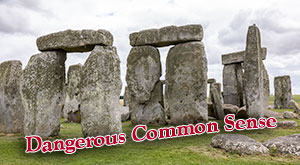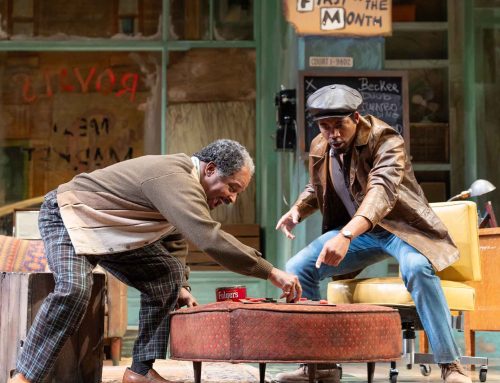World Premiere
Opening Performance, February 25, 2012
at the Oregon Shakespeare Festival
The White Snake
Written and Directed by Mary Zimmerman
Playwright Mary Zimmerman has distilled an ancient, often modified, Chinese legend of The White Snake into a coherent, relevant, engrossing, artistic, and accessible 138-minute story. The text is stylized and full of Eastern cultural references, but Zimmerman’s lively, humorous, and rich approach somehow [“somehow” as in “the magic happens here”] honors the fable’s roots while letting it transcend its place and time of origin.
The White Snake avoids being artsy fartsy as Zimmerman’s works have been in the past (I’m thinking specifically of Berkeley Rep’s Metamorphoses which I disliked, its later Broadway Tony notwithstanding), and instead rises to a mesmerizing blend of straight-forward narrative, stylized symbolism, humor, gorgeous visuals, and conflicting morality. The Oregon Shakespeare Festival’s own January-deadline publications warned that the script had not yet been written, yet at its opening the play was polished, professional, and ready for prime time.
The White Snake’s strength is that tells simply an understandable story. The audience is let in on the basic plot points and is free to enjoy the brilliantly executed telling. The puppets, Chinese dress, cultural iconography feel engaging and not something you have to struggle to decode to appreciate. In fact, we’re explicitly clued in on some of the stylizations in a humorous, but truly informative, way.
What happens can be explained in a paragraph or two (see the Wikipedia link above). What makes The White Snake a powerful event are the on-stage crafts, acting, and live musicians. No part is more important than the other, and I wish my own paragraphs of praise could rotate so that top billing is shared.
The show starts with music, and that’s a good place to begin the applause. I loved Tessa Brickman’s flute, Ronnie Mallery’s strings and percussion, and Michael Palzewicz’s cello. The original music by Andre J. Pluess put us in the mood at the performance’s start and enriched the experience every moment forward. Sometimes playful, sometimes background, occasionally spotlighted, the tonal sounds were worthy equals to the words and sights. Most of the music felt Chinese, but the bearable hip hop moments made sure we knew we weren’t stuck in the past.
Daniel Ostling’s set is clean, sparse, adequate, and flowing. The company makes excellent use of fabric for wind and water. You don’t just see the elements, you feel them on your skin. The changing video backgrounds are simultaneously unexpected, mostly non-realistic, and exactly right.
The costumes are not just background accoutrements. The key White and Green Snake characters appear as puppets, single humans, and also as multi-character, individually-dressed snake segments. Monks, customers, and people on the street are identified and classified by what they wear. Costume designer Mara Blumenfeld’s creations are worthy works of art that add their own harmony to the tale.
For the most part the materials and styling are jaw-droppingly beautiful. The Chinese prints and construction are integral parts of the overall on-stage atmosphere. The multi-part snakes are a terrific look, and even if their animation is also part direction and part acting, much of their life comes from Blumenfeld’s design. The few garments for lower-positioned people seem accurate and fitting, but I’ll remember the richer robes for a longer time.
The play’s title character is portrayed by Amy Kim Waschke. She moves flawlessly from stylization to straight character acting with style, giving her role necessary class, grace, weight, and cohesion.
The Green Snake (Tanya McBride) gets the scene-stealing lines and actions. McBride delivers the right amount of boundless energy, perfectly controlled. Her Green Snake is impetuous, young, inventive, and strong. She does, indeed, steal many scenes.
Xu Xian (Christopher Livingston) is played with adorable likeableness. The character is completely out of his league, and Livingston gives us the exact guileless openness and instinctive devotion that the fable needs. Plus, he is cute.
The rigid Monk Fa Hai (Jack Willis) gives this production a modern political message. Willis’ characterization is of a Rick Santorum/Pat Robertson Buddhist fundamentalist which makes Fa Hai a clear villain in this version of the legend. The slant works well, and since the playwright and director are the same, is obviously meant to be. Still, I wonder if Fa Hai seemed more sincere and concerned about upholding the tenents of his faith – and less a bombastic jerk – would the story be stronger?
The other actors, including those only credited as being in the ensemble, are also completely strong in the their craft. Their movements, lines, and visual support were creative and appreciated. “Appreciated” is too thin a word, but the main problem I have writing more about the production is that I am running out of adequate synonyms for “damn great”.
The White Snake is surprising and wonderful theater. It’s a good story, excellently extracted and written, played out expertly on the stage with music, movement, and words. Although brand new, no flaws grabbed me. Its running time is a bit awkward, and I would probably find 10 minutes to cut, but where? The experience is a memory-producing winner.
Ozdachs Rating: ![]()






Yay, I’m really looking forward to this one!